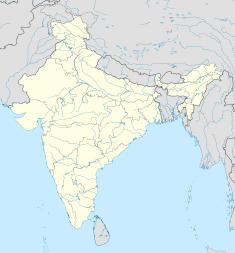This is an old revision of this page, as edited by 2405:204:67a2:bc95:485d:45c:1e3d:4de4 (talk) at 01:37, 7 October 2019 (→Collections). The present address (URL) is a permanent link to this revision, which may differ significantly from the current revision.
Revision as of 01:37, 7 October 2019 by 2405:204:67a2:bc95:485d:45c:1e3d:4de4 (talk) (→Collections)(diff) ← Previous revision | Latest revision (diff) | Newer revision → (diff)Historic site in Tamil Nadu, India
| Kodumanal | |
|---|---|
 | |
| Location | Erode, Tamil Nadu, India |
| Coordinates | 11°00′45″N 78°09′36″E / 11.0125°N 78.16°E / 11.0125; 78.16 |
Kodumanal is a village located in the Erode district in the southern Indian state of Tamil Nadu. It was once a flourishing ancient trade city known as Kodumanam, as inscribed in Patittrupathu of Sangam Literature. The place is an important archaeological site, under the control of State Archaeological Department of Tamil Nadu. It is located on the northern banks of Noyyal River, a tributary of the Cauvery.
The ancient city
The inhabitants of this destroyed ancient city of Chera dynasty were highly skilled craftsmen, who were specialized in making beads and high-quality iron. The place is referred to in Sangam literature as an important industrial centre that had links with the Chola port city of Kaveripoompattinam, now called Poompuhar.
Roman trade route
The city played a major role in Indo-Roman trade and relations, as the ancient city is located on the mid-way of a Roman trade route, linking Muziris port on the Malabar Coast with the Kaveripoompattinam (Puhar) Port in the Coromandel Coast.
Megalithic tombs
Excavations have been carried out and it came out with the layers of a megalithic-cum-early tombs of historic period. Also there were two female and one male human skeleton were recovered from a pit burial in this site. A set of 300 megalithic tombs of different types and sizes were observed and recorded in this area. The ancient city has been destroyed in time and now the area is available with the remains of a megalithic settlement dating back to the 2nd century BC. Apparently, this was the centre for the Romans who visited to obtain beryls from Kodumanal. The megalithic communities that flourished in this site belong to the period of 2nd century BC to 2nd century AD.
Iron and metal
The iron and steel furnaces and iron artefacts produced in these places revealed the technical advancement made by the iron smelters around 500 BC. The excavated sword bit contained spheroidal graphite phase and forge welding of high-carbon cutting edge. This place was once celebrated for its trade in precious stones like garnet, carnelian, lapis lazuli, sapphire and quartz. The people of this city were experts in manufacturing the finest iron.
Collections
Excavations uncovered ancient iron objects such as arrow heads and swords. They also produced Roman artefacts, iron melting furnaces, beads, shell bangles and pottery with the Tamizhi scripts (from the habitation deposits and burials). Other artifacts uncovered during the excavation of this site include roulette pottery, Roman silver coins, and gold and silver spirals. A bronze statue of a lion and the iron melting furnaces were important to deciphering the site's history.
References
- ^ "Stone spell". The Hindu. India. 19 March 2005.
- "Kodumanal likely to get a new lease of life with excavation". The Hindu. Erode, Tamil Nadu, India. 4 April 2007.
- The Hindu - Mar 2011
- "Following the Roman trail". The Hindu. India. 17 August 2003.
- "'More studies needed at Pattanam'". The Hindu. Chennai, India. 24 May 2013.
- Indian Journal of History & Science,37.1,2002,17-29 (through "Digital Library of India")
- Indian Journal of History & Science,34(4),1999 (through "Digital Library of India") Archived 2015-09-23 at the Wayback Machine
- "Excavations at Kodumanal village unearth more ancient objects". The Hindu. 10 May 2018. ISSN 0971-751X. Retrieved 24 June 2019.
- "A great past in bright colours". Frontline. India. 8 October 2010. Archived from the original on 3 February 2011.
- http://www.flonnet.com/stories/20120810291506200.htm
- "BIG discovery: A 2,500-year-old industrial estate!". Rediff. Retrieved 24 June 2019.
- Subramanian, T. S. (28 May 2012). "Kodumanal excavation yields a bonanza again". The Hindu. Chennai, India.
- "KODUMANAL ERODE EXCAVATION". www.tnarch.gov.in. Retrieved 7 May 2016.
External links
- https://books.google.com/books?id=H3lUIIYxWkEC&pg=PA402&lpg=PA402&dq=kodumanal+called+as&source=bl&ots=xcdC8QeVjA&sig=AUsc9aTBsG5d-EzNqgRm2esbDoc&hl=en&ei=a5xbTZ39N4a4vgP4jOnfDA&sa=X&oi=book_result&ct=result&resnum=2&ved=0CBgQ6AEwATgK#v=onepage&q&f=false
- https://books.google.com/books?id=zzZBdGQN_TIC&pg=PA122&lpg=PA122&dq=kodumanal+called+as&source=bl&ots=eY2rXArdfM&sig=FawJfjzSIwiYR3UGbwr1Xx6PZa4&hl=en&ei=a5xbTZ39N4a4vgP4jOnfDA&sa=X&oi=book_result&ct=result&resnum=3&ved=0CBsQ6AEwAjgK#v=onepage&q=kodumanal%20called%20as&f=false
- http://kodumanal.blogspot.com/2008/07/genesis-of-ukku-insights-from.html
- http://kodumanal.blogspot.com/2008/07/anchor.html
- https://web.archive.org/web/20060321084351/http://www.thebeadsite.com/UNI-MAPS.html
- http://www.krepublishers.com/02-Journals/T-Anth/Anth-06-0-000-000-2004-Web/Anth-06-2-091-157-2004-Abst-PDF/Anth-06-2-105-112-2004-Reddy-V-R/Anth-06-2-105-112-2004-Reddy-V-R.pdf
- http://www.new.dli.ernet.in/rawdataupload/upload/insa/INSA_1/2000c951-385.pdf
- http://www.thehindu.com/arts/history-and-culture/article3465932.ece
